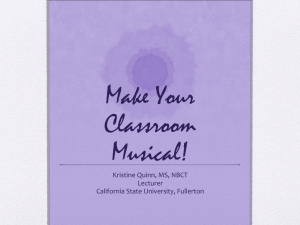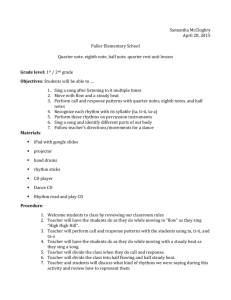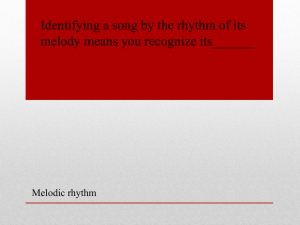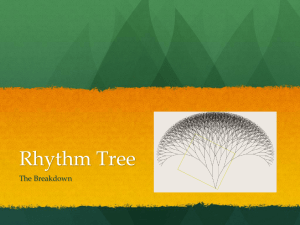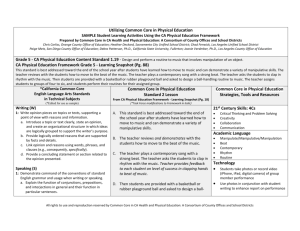5 th Grade Lesson Plans - Edon Northwest Local School
advertisement
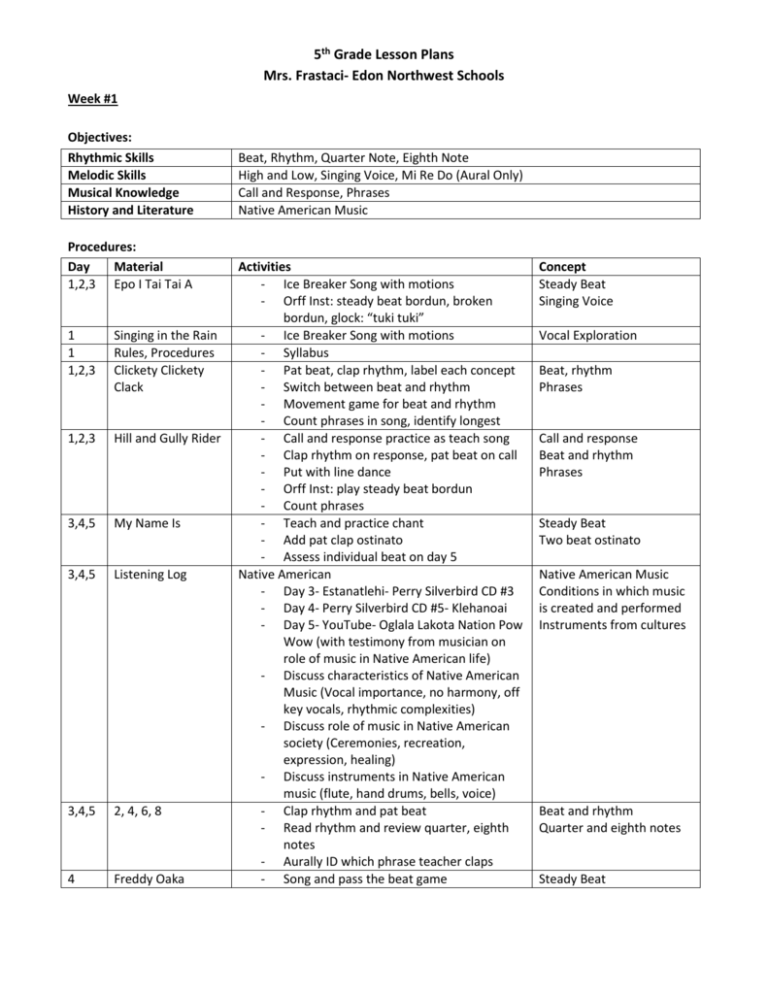
5th Grade Lesson Plans Mrs. Frastaci- Edon Northwest Schools Week #1 Objectives: Rhythmic Skills Melodic Skills Musical Knowledge History and Literature Procedures: Day Material 1,2,3 Epo I Tai Tai A 1 1 1,2,3 Singing in the Rain Rules, Procedures Clickety Clickety Clack 1,2,3 Hill and Gully Rider 3,4,5 My Name Is 3,4,5 Listening Log 3,4,5 2, 4, 6, 8 4 Freddy Oaka Beat, Rhythm, Quarter Note, Eighth Note High and Low, Singing Voice, Mi Re Do (Aural Only) Call and Response, Phrases Native American Music Activities - Ice Breaker Song with motions - Orff Inst: steady beat bordun, broken bordun, glock: “tuki tuki” - Ice Breaker Song with motions - Syllabus - Pat beat, clap rhythm, label each concept - Switch between beat and rhythm - Movement game for beat and rhythm - Count phrases in song, identify longest - Call and response practice as teach song - Clap rhythm on response, pat beat on call - Put with line dance - Orff Inst: play steady beat bordun - Count phrases - Teach and practice chant - Add pat clap ostinato - Assess individual beat on day 5 Native American - Day 3- Estanatlehi- Perry Silverbird CD #3 - Day 4- Perry Silverbird CD #5- Klehanoai - Day 5- YouTube- Oglala Lakota Nation Pow Wow (with testimony from musician on role of music in Native American life) - Discuss characteristics of Native American Music (Vocal importance, no harmony, off key vocals, rhythmic complexities) - Discuss role of music in Native American society (Ceremonies, recreation, expression, healing) - Discuss instruments in Native American music (flute, hand drums, bells, voice) - Clap rhythm and pat beat - Read rhythm and review quarter, eighth notes - Aurally ID which phrase teacher claps - Song and pass the beat game Concept Steady Beat Singing Voice Vocal Exploration Beat, rhythm Phrases Call and response Beat and rhythm Phrases Steady Beat Two beat ostinato Native American Music Conditions in which music is created and performed Instruments from cultures Beat and rhythm Quarter and eighth notes Steady Beat 5th Grade Lesson Plans Mrs. Frastaci- Edon Northwest Schools 4,5 Lines and Spaces - 2,3,4 Orff Instruments - 5 Chimes of Dunkirk - Introduce treble clef lines and spaces chant Playing position Names of instruments Care of instruments Rotations Hands together, alternate, start and stop, bordun, broken bordun Body Director- Mallet Madness p.23 Melodic Direction- Jack and Jill Story 8 beat improvisation, end on do Step By Step- Mallet Madness S.A. p. 11 Dance from Chimes of Dunkirk book, CD Note Names Orff Instrument Basic Skills Playing Techniques Improvisation High and low Folk Dances Standards: (Highlighted) 1CE Explore and identify musical instruments from different historical periods and world cultures. 2CE Listen to, identify, and respond to music of different composers, historical periods and world cultures. 3CE Identify terms related to form (e.g., D.C. and D.S. al Fine; D.C. and D.S. al Coda; repeat signs, first and second endings). 4CE Recognize and identify longer music forms (e.g., sonata, 12-bar blues, and theme and variations). 5CE Identify elements of music including tonality, dynamics, tempo and meter, using music vocabulary. 6CE Differentiate between melody and harmony. 7CE Identify patterns of whole and half steps in a major scale. 1PR Sing a varied repertoire with accurate rhythm and pitch, appropriate expressive qualities, good posture and breath control. 2PR Perform, on instruments, a varied repertoire with accurate rhythm and pitch, appropriate expressive qualities, good posture and breath control. 3PR Improvise, compose and arrange music. 4PR Use technology and the media arts to create and perform music. 5PR Read, write and perform using sixteenth through whole note values including syncopated rhythms and dotted-half notes in 2/4, 3/4 and 4/4meter. 6PR Read, write and perform diatonic melodies and the major scale on the treble staff. 7PR Demonstrate appropriate audience etiquette at live performances. 1RE Justify personal preferences for certain musical pieces, performances, composers and musical genres both orally and in writing. 2RE Discuss contributions of musical elements to aesthetic qualities in performances of self and others. 3RE Describe how the process of learning in music connects to learning in other arts and other subject areas. 4RE Defend interpretations of music via dance, drama and visual art using appropriate vocabulary. 5RE Consider and articulate the influence of technology on music careers. 6RE Develop and apply criteria for critiquing more complex performances of live and recorded music. 5th Grade Lesson Plans Mrs. Frastaci- Edon Northwest Schools Week #2 Objectives: Rhythmic Skills Melodic Skills Musical Knowledge History and Literature Procedures: Day Material 1,2,3,4,5 Listening Log 1,2,3,4,5 Lines and Spaces 1,2,3,4,5 Melodic Warm-ups 1,2,3,4,5 Rhythmic Warmups 1,2 A Ram Sam Sam 1 2, 4, 6, 8 1, 5 Crazy Eights Beat, Rhythm, Quarter Note, Eighth Note, Quarter Rest, Half Note Singing Voice, Mi Re Do (Keys of F and G), Names of Treble Clef Notes Canon, Lines and Spaces on staff Folk Music Activities American Folk Music - Day 1- Jean Ritchie, Hangman - Day 2- Pete Seeger and Jean RitchieJenny Jenkins - Day 3- Whistler’s Jug Band- Fold in Band - Day 4- David Holt and Doc WatsonShady Grove (start 1:20) - Day 5- Jean Ritchie Movie 1998 Folk Alliance International Lifetime Achievement Award documentary (05:00, then 8:00 on) - Discuss role of music in Jean Ritchie’s life growing up, why she started writing music, what historical events caused her to write music - Discuss instruments used in folk music (lap harp, guitar, jugs, harmonica, banjo, dulcimer, etc.) - Discuss technology and Jean Ritchie’s music career - Treble clef lines and spaces chant - Identify lines, spaces, and staff - Echo m-r-d patterns - Sing from hand signs - Memory work - Read rhythm flashcards - Echo patterns and memory work - Learn song and motions - Sing song in canon - Identify and discuss canon - Review song, eighth note, quarter note - Put phrases in order on board (copies from MM) - Read song from notation - Orff Inst.: Mallet Madness p.35 - Mallet Madness p.30 Concept Folk Music Conditions in which music is created and performed Instruments from cultures Influence of history on folk music Technology and music careers Note Names Lines and spaces Mi, re, do Aural training Quarter, eighth, rest, half Canon Quarter note, eighth note Quarter rest 5th Grade Lesson Plans Mrs. Frastaci- Edon Northwest Schools 1,2,4 Hot Cross Buns - 3 3 Alabama Gal Cup and Rhythm Stick Game - 2,4 Perot 4, 5 Brother John - 4 4 5 Jack and Jill Direction Dots Here Comes A Bluebird 5 Rhythm Boards - Review rests Transfer to walking Orff inst: Click mallets on rests, only play on rests. Orff Source #42 Ionic notation chart- high, middle, low change to mi, re, do Body motions in levels created with partner My 3rd Grade Music Book p.15 as group My 3rd Grade Music Book p.16 individually Dance from Chimes of Dunkirk book, CD To “Tell My Ma” song, four beat rhythm patterns of quarter notes and rests that students tap to Learn song from solfege Transfer to staff notation (melodic only) Sing song while pointing to heart beat chart Sing song while clapping rhythm Find longest words Move only on long words Walk rhythm patterns Read stick notation for first line Orff Inst: Mallet Madness p. 34 Mallet Madness Strikes Again p.58 Sing song and play game Identify longest words Clap rhythm and pat beat With partners, notate given rhythms on rhythm boards Compose own 8 beat rhythm, perform Mi, re, do (key of F and G) Quarter Rest Folk Dance Feeling four Quarter Note and Rests Mi, re, do Prepare Half Notes Mi, re , do Rest Melodic Direction Prepare Half Notes Quarter, eighth, rests Standards: (Highlighted) 1CE Explore and identify musical instruments from different historical periods and world cultures. 2CE Listen to, identify, and respond to music of different composers, historical periods and world cultures. 3CE Identify terms related to form (e.g., D.C. and D.S. al Fine; D.C. and D.S. al Coda; repeat signs, first and second endings). 4CE Recognize and identify longer music forms (e.g., sonata, 12-bar blues, and theme and variations). 5CE Identify elements of music including tonality, dynamics, tempo and meter, using music vocabulary. 6CE Differentiate between melody and harmony. 7CE Identify patterns of whole and half steps in a major scale. 1PR Sing a varied repertoire with accurate rhythm and pitch, appropriate expressive qualities, good posture and breath control. 2PR Perform, on instruments, a varied repertoire with accurate rhythm and pitch, appropriate expressive qualities, good posture and breath control. 3PR Improvise, compose and arrange music. 4PR Use technology and the media arts to create and perform music. 5PR Read, write and perform using sixteenth through whole note values including syncopated rhythms and dotted-half notes in 2/4, 3/4 and 4/4meter. 6PR Read, write and perform diatonic melodies and the major scale on the treble staff. 7PR Demonstrate appropriate audience etiquette at live performances. 1RE Justify personal preferences for certain musical pieces, performances, composers and musical genres both orally and in writing. 2RE Discuss contributions of musical elements to aesthetic qualities in performances of self and others. 3RE Describe how the process of learning in music connects to learning in other arts and other subject areas. 4RE Defend interpretations of music via dance, drama and visual art using appropriate vocabulary. 5RE Consider and articulate the influence of technology on music careers. 6RE Develop and apply criteria for critiquing more complex performances of live and recorded music. 5th Grade Lesson Plans Mrs. Frastaci- Edon Northwest Schools Week #3 Objectives: Rhythmic Skills Melodic Skills Musical Knowledge History and Literature Procedures: Day Material 1,2,3,4,5 Listening Log 1,2,3,4,5 Lines and Spaces 1,2,3,4,5 Melodic Warm-ups 1,2,3,4,5 Rhythmic Warmups 1,2 Brother John 1 L’Arlesienne Suites 1 Here Comes A Bluebird 1,3, 5 Knock the Cymbals Half Note, 2 and 4 beat meter, bar line, double bar line, measure Mi Re Do (Keys of F, C and G), Names of Treble Clef Notes, Aural so and la Phrases, Tempo, Lines and Spaces on staff Blues Music Activities Blues and Jazz - Day 1- Robert Johnson- Sweet Home Chicago - Day 2- Mamie Smith- Crazy Blues - Day 3- Duke Ellington- It Don’t Mean A Thing - Day 4- Jelly Roll Martin- Steamboat Stomp - Day 5- Ella Fitzgerald- Summertime - Discuss development of jazz and bluesboth from southern states at the end of the 19th century, African Americans, blues- sad, slow music, 12 bar blues; jazzcombined American and African music, many forms - Discuss instruments used in jazz (piano, bass, drum set, sax, trumpet, trombone) - Treble clef lines and spaces chant - Start daily timed competition - Echo l-s-m-r-d patterns - Sing from hand signs - Memory work - Read rhythm flashcards - Echo patterns and memory work - 2nd Grade Music Book p. 29 - Clap and count rhythm patterns from song - Transfer stick notation to staff notation1st phrase - Listening Lessons- p. 38 - Sing ostinato with hand sings and solfege - Read song from notation- 2nd grade music book p. 73 - Identify half notes - Move only on half notes game - Song and dance Concept Blue and Jazz Conditions in which music is created and performed Instruments from cultures Influence of history Note Names La, so, mi, re, do Aural training Quarter, eighth, rest, half Half Notes Mi, re , do Mi, re, do Half Notes Half note 5th Grade Lesson Plans Mrs. Frastaci- Edon Northwest Schools - 2, 5 Rocky Mountain - 3 Staff Boards - 3 Wiegenlied 3 Cup and Rhythm Stick Game - 4 5 Durham Reel Rhythm Boards - 5 Sorida Standards: (Highlighted) 1CE Explore and identify musical instruments from different historical periods and world cultures. 2CE Listen to, identify, and respond to music of different composers, historical periods and world cultures. 3CE Identify terms related to form (e.g., D.C. and D.S. al Fine; D.C. and D.S. al Coda; repeat signs, first and second endings). 4CE Recognize and identify longer music forms (e.g., sonata, 12-bar blues, and theme and variations). 5CE Identify elements of music including tonality, dynamics, tempo and meter, using music vocabulary. 6CE Differentiate between melody and harmony. 7CE Identify patterns of whole and half steps in a major scale. - 2nd Grade Music Book p. 79- count and clap rhythms Find half note in song Count beats in song Sing with four beat ostinatos Sing at allegro, moderato, and largo Find bar line, double bar line, and measures Identify four beat measures Learn song Isolate mrd patterns, solfege replacement Four beat clapping ostinato Create four beat pattern with partner and perform Orff Inst: Orff Source #56 (simplified) 2nd Grade music book p. 78- Find half notes, bar line, double bar line, two beat measure With partners, write various patterns using m, r, and do in keys of F and G Listening Lessons- p. 41 Read melodic flashcards from song To “Tell My Ma” song, four beat rhythm patterns of quarter notes and rests that students tap to Dance- Chimes of Dunkirk book and CD With partners, notate given rhythms on rhythm boards Compose own 8 beat rhythm and perform Song and hand clapping game 1PR Sing a varied repertoire with accurate rhythm and pitch, appropriate expressive qualities, good posture and breath control. 2PR Perform, on instruments, a varied repertoire with accurate rhythm and pitch, appropriate expressive qualities, good posture and breath control. 3PR Improvise, compose and arrange music. 4PR Use technology and the media arts to create and perform music. 5PR Read, write and perform using sixteenth through whole note values including syncopated rhythms and dotted-half notes in 2/4, 3/4 and 4/4meter. 6PR Read, write and perform diatonic melodies and the major scale on the treble staff. 7PR Demonstrate appropriate audience etiquette at live performances. Bar line, double bar line, measures, four beat measures Allegro, moderato, and largo Mi, re, do Half notes Bar line, double bar line, measures, two beat measures Mi, re, do Mi, re, do Feeling four Quarter Note and Rests Folk Dance Quarter, eighth, rests, half Prepare so 1RE Justify personal preferences for certain musical pieces, performances, composers and musical genres both orally and in writing. 2RE Discuss contributions of musical elements to aesthetic qualities in performances of self and others. 3RE Describe how the process of learning in music connects to learning in other arts and other subject areas. 4RE Defend interpretations of music via dance, drama and visual art using appropriate vocabulary. 5RE Consider and articulate the influence of technology on music careers. 6RE Develop and apply criteria for critiquing more complex performances of live and recorded music. 5th Grade Lesson Plans Mrs. Frastaci- Edon Northwest Schools Week #4 Objectives: Rhythmic Skills Melodic Skills Musical Knowledge History and Literature Procedures: Day Material 1,2,3,4,5 Listening Log 1,2,3,4,5 Lines and Spaces 1,2,3,4,5 Melodic Warm-ups 1,2,3,4,5 Rhythmic Warmups 1 Sorida 1,2 Laugh Ha Ha 1 1 Could It Be DRM? Rocky Mountain 1,2 Who’s That Tapping 2 and 4 beat meter, bar line, double bar line, measure, whole note Mi Re Do (Keys of F, C and G), Names of Treble Clef Notes, so and la (key of F) Tempo, March form, improvisation, canon Spirituals and Hymns Activities Spirituals and Hymns - Day 1- Shall We Gather at the RiverWilliam Appling Singers - Day 2- Abide with Me- Mormon Tabernacle Choir - Day 3- Wade in the Water- Ella Jenkins - Day 4- Precious Lord Take My HandMahalia Jackson - Day 5- Swing Low Sweet Chariot- Etta James - Discuss development of hymns and spirituals- religious songs with spiritual lyrics, spirituals came from days of slavery, used in many Christian churches today - Discuss instruments used in spirituals and hymns (piano, organ) - Treble clef lines and spaces chant - Start daily timed competition - Echo l-s-m-r-d patterns - Sing from hand signs - Memory work - Read rhythm flashcards - Echo patterns and memory work - Sing song and play game - Sing with solfege- identify so - Sing allegro, moderato, and largo - Sing song in canon - Find mmrd in last phrase - On projector- discuss as class - Find l,s,m,d phrase and sing with solfege - Find that phrase on 2nd grade music book p. 78 - Sing song, play game - Read from 2nd grade music book p.64 - Find half notes, bar lines, double bar Concept Spirituals and Hymns Conditions in which music is created and performed Instruments from cultures Text and lyrics Note Names La, so, mi, re, do Aural training Quarter, eighth, rest, half, whole So, mi, do Tempos Canon Mi, re, do Mi, re, do La, so, mi, do Half note Bar line, double bar line, measures, four beat 5th Grade Lesson Plans Mrs. Frastaci- Edon Northwest Schools 2, 5 2 3 3 3 4 Somebody’s Knocking at the door The Sweets of May Fuzzy Wuzzy I-M-P-R-O-V-I-S-E Three Steps Up Rhythm Compositions - 5 Staff Boards - 5 El Capitan - lines, measures, and four beat measures Sing and knock four times on whole note Find and identify longest note Do motions four beats long on whole note Write rhythm on board for “door” Read rhythms with whole note Dance- Chimes of Dunkirk book and CD Orff Inst: Mallet Madness p. 42 Orff Inst: Mallet Madness SA p. 76 Orff Inst: Mallet Madness SA p. 12 With partner, create 16 beat rhythms using known rhythms Perform on unpitched percussion instruments With partners, write various patterns using m, r, and do in keys of F and G Listening Lesson p.70 with cups Discuss sections of march form measures Whole note Folk Dance Phrases Improvisation Mallet technique Compositions La, so, mi, re, do March Movement to form Standards: (Highlighted) 1CE Explore and identify musical instruments from different historical periods and world cultures. 2CE Listen to, identify, and respond to music of different composers, historical periods and world cultures. 3CE Identify terms related to form (e.g., D.C. and D.S. al Fine; D.C. and D.S. al Coda; repeat signs, first and second endings). 4CE Recognize and identify longer music forms (e.g., sonata, 12-bar blues, and theme and variations). 5CE Identify elements of music including tonality, dynamics, tempo and meter, using music vocabulary. 6CE Differentiate between melody and harmony. 7CE Identify patterns of whole and half steps in a major scale. 1PR Sing a varied repertoire with accurate rhythm and pitch, appropriate expressive qualities, good posture and breath control. 2PR Perform, on instruments, a varied repertoire with accurate rhythm and pitch, appropriate expressive qualities, good posture and breath control. 3PR Improvise, compose and arrange music. 4PR Use technology and the media arts to create and perform music. 5PR Read, write and perform using sixteenth through whole note values including syncopated rhythms and dotted-half notes in 2/4, 3/4 and 4/4meter. 6PR Read, write and perform diatonic melodies and the major scale on the treble staff. 7PR Demonstrate appropriate audience etiquette at live performances. 1RE Justify personal preferences for certain musical pieces, performances, composers and musical genres both orally and in writing. 2RE Discuss contributions of musical elements to aesthetic qualities in performances of self and others. 3RE Describe how the process of learning in music connects to learning in other arts and other subject areas. 4RE Defend interpretations of music via dance, drama and visual art using appropriate vocabulary. 5RE Consider and articulate the influence of technology on music careers. 6RE Develop and apply criteria for critiquing more complex performances of live and recorded music. 5th Grade Lesson Plans Mrs. Frastaci- Edon Northwest Schools Week #5 Objectives: Rhythmic Skills Melodic Skills Musical Knowledge History and Literature Procedures: Day Material 1 Catch-Up Day 2,3,4,5 Listening Log 2,3,4,5 Lines and Spaces 2,3,4,5 Melodic Warm-ups 2,3,4,5 2 Rhythmic Warmups What am I singing? Laugh Ha Ha Somebody’s Knocking El Capitan 2, 3 Rocky Mountain 2 2 2 Whole note, 3 beat meter, dotted half note Pentatonic key of F, G, Names of Treble Clef Notes Improvisation, Composition, March Form Patriotic Music Activities Catch-up from shortened or missed classes Patriotic Music - Day 2- Star Spangled Banner- Beyonce at Inaguration - Day 3- America the Beautiful- Choir of Washington National Cathedral - Day 4- Battle Hymn of the RepublicJohnny Cash - Day 5- Yankee Doodle - Discuss purpose of patriotic music (instill pride and support of one’s country) - Discuss instruments used in patriotic music (traditional instruments of that country) - Describe when patriotic music is used today (games, inaugurations, Olympics, war time, commercials, etc.) - Treble clef lines and spaces chant - Start daily timed competition - Echo l-s-m-r-d patterns - Sing from hand signs - Memory work - Read rhythm flashcards - Echo patterns and memory work - 3rd Grade Music Book p. 80 - Sing song in canon - Identify whole notes - Read rhythms that use whole notes - Listening Lesson p.70 with cups - Discuss sections of march form - Label note names in song - Find bar line, double bar line, measure, four beat measure on 2nd grade music book p. 78 - Learn melody on barred instruments with partner from notation Concept Patriotic Music Conditions in which music is created and performed Instruments from cultures Text and lyrics Note Names La, so, mi, re, do Aural training Quarter, eighth, rest, half, whole, dotted half Mi, re, do Canon Whole note March Movement to form Absolute pitch names Bar line, double bar line, measure, four beat measure Melody 5th Grade Lesson Plans Mrs. Frastaci- Edon Northwest Schools 3 4, 5 4,5 Down the River Derry Ding Dong Dason Oh How Lovely Is the Evening 4,5 Morning Has Come 4, 5 Tennis Ball Time Signatures I-M-P-R-O-V-I-S-E 5 - Label melody Dance and song Sing with three beat ostinato Read from projector (Karla’s score) Sing with three beat ostinato Read from projector (Karla’s score) Identify dotted half notes and ¾ time Sing in canon Identify dotted half notes and ¾ time Sway at each measure Orff Inst: Play dotted half notes to song and various ¾ ostinatos Walk and bounce tennis balls to different times signatures Orff Inst: Mallet Madness SA p. 76 Folk Dance ¾ time ¾ time Dotted Half Notes ¾ time Dotted Half Notes 3/4, 2/4, 4/4 Improvisation Standards: (Highlighted) 1CE Explore and identify musical instruments from different historical periods and world cultures. 2CE Listen to, identify, and respond to music of different composers, historical periods and world cultures. 3CE Identify terms related to form (e.g., D.C. and D.S. al Fine; D.C. and D.S. al Coda; repeat signs, first and second endings). 4CE Recognize and identify longer music forms (e.g., sonata, 12-bar blues, and theme and variations). 5CE Identify elements of music including tonality, dynamics, tempo and meter, using music vocabulary. 6CE Differentiate between melody and harmony. 7CE Identify patterns of whole and half steps in a major scale. 1PR Sing a varied repertoire with accurate rhythm and pitch, appropriate expressive qualities, good posture and breath control. 2PR Perform, on instruments, a varied repertoire with accurate rhythm and pitch, appropriate expressive qualities, good posture and breath control. 3PR Improvise, compose and arrange music. 4PR Use technology and the media arts to create and perform music. 5PR Read, write and perform using sixteenth through whole note values including syncopated rhythms and dotted-half notes in 2/4, 3/4 and 4/4meter. 6PR Read, write and perform diatonic melodies and the major scale on the treble staff. 7PR Demonstrate appropriate audience etiquette at live performances. 1RE Justify personal preferences for certain musical pieces, performances, composers and musical genres both orally and in writing. 2RE Discuss contributions of musical elements to aesthetic qualities in performances of self and others. 3RE Describe how the process of learning in music connects to learning in other arts and other subject areas. 4RE Defend interpretations of music via dance, drama and visual art using appropriate vocabulary. 5RE Consider and articulate the influence of technology on music careers. 6RE Develop and apply criteria for critiquing more complex performances of live and recorded music. 5th Grade Lesson Plans Mrs. Frastaci- Edon Northwest Schools Week #6 Objectives: Rhythmic Skills Melodic Skills Musical Knowledge History and Literature Procedures: Day Material 1,2,3,4,5 Listening Log 1,2,3,4,5 Lines and Spaces 1,2,3,4,5 Melodic Warm-ups 1,2,3,4,5 Rhythmic Warmups 1 1 Procession of the Nobles Alpha Three 3 beat meter, dotted half note, sixteenth notes Pentatonic key of F, G, Names of Treble Clef Notes, Low so, low la Rondo Form Marches, Ragtime Activities Marches and Ragtime - Day 1- Stars and Stripes Forever, SousaUS Marine Band - Day 2- El Capitan, Sousa- Army Field Band - Day 3- The Entertainer- Scott Joplin - Day 4- Maple Leaf Rag- Scott Joplin - Day 5- Colonel Bogey March- Ricketts - Discuss marches- Strong, regular rhythm, often marched to, often played by military bands or concert bands, John Phillips Sousa - Discuss ragtime music- variation on march by adding syncopated rhythms, Scott Joplin, popular around 1900 - Discuss instruments used in marches (concert band) and rags (piano) - Treble clef lines and spaces chant - Start daily timed competition - Echo l-s-m-r-d patterns - Sing from hand signs - Memory work - Read rhythm flashcards - Echo patterns and memory work - 2,3 Chicken in the Fencepost - Guided Listening Lesson from Level 3 Follow along notation with melody Solomon’s the Body Round Book- Alpha Three Discuss rondo form- ABACA Partners learn one section (A, B, or C) and then join with two other groups Put together in each large group and perform Learn song, play game Find four quick sounds per beat Concept Patriotic Music Conditions in which music is created and performed Instruments from cultures Text and lyrics Note Names La, so, mi, re, do Aural training Quarter, eighth, rest, half, whole, dotted half, sixteenth 3/4 ¾ time Rondo form Sixteenth Notes 5th Grade Lesson Plans Mrs. Frastaci- Edon Northwest Schools - 2,3 Dinah - 4 Tideo 5 Alligator Pie - 5 Hangman 5 Scotland’s Burning 5 Chickalileelo - 3rd grade music book p.26- find 4 sounds per beat Put four quick motions to 16th notes 3rd grade music book p. 88- read rhythms Learn song, do motions on 16ths As American p. 21- Dance and Orff Instruments with interlude Grade 3 Music Book p.27- find four sounds per beat Grade 3 Music Book p.30- worksheet- fill in 16th notes Find bar lines, double bar lines, measures, two beat measures Sing song and learn dance Orff Inst: As American p.10 3rd Grade music book p. 28 Read rhythm and complimentary rhythm on projector Play on unpitched percussion instruments Listen to all verses of song Echo sing on solfege with hand signs Read from 4th Grade Music Book p.43 Sing song with motions Show pitch levels with hands Echo sing phrases on solfege Point down on lowest note (so,) Read phrase one from board Sixteenth Notes Bar line, double bar line, measure, two beat measure Sixteenth Notes Sixteenth Notes Low la Low so Low so and la Standards: (Highlighted) 1CE Explore and identify musical instruments from different historical periods and world cultures. 2CE Listen to, identify, and respond to music of different composers, historical periods and world cultures. 3CE Identify terms related to form (e.g., D.C. and D.S. al Fine; D.C. and D.S. al Coda; repeat signs, first and second endings). 4CE Recognize and identify longer music forms (e.g., sonata, 12-bar blues, and theme and variations). 5CE Identify elements of music including tonality, dynamics, tempo and meter, using music vocabulary. 6CE Differentiate between melody and harmony. 7CE Identify patterns of whole and half steps in a major scale. 1PR Sing a varied repertoire with accurate rhythm and pitch, appropriate expressive qualities, good posture and breath control. 2PR Perform, on instruments, a varied repertoire with accurate rhythm and pitch, appropriate expressive qualities, good posture and breath control. 3PR Improvise, compose and arrange music. 4PR Use technology and the media arts to create and perform music. 5PR Read, write and perform using sixteenth through whole note values including syncopated rhythms and dotted-half notes in 2/4, 3/4 and 4/4meter. 6PR Read, write and perform diatonic melodies and the major scale on the treble staff. 7PR Demonstrate appropriate audience etiquette at live performances. 1RE Justify personal preferences for certain musical pieces, performances, composers and musical genres both orally and in writing. 2RE Discuss contributions of musical elements to aesthetic qualities in performances of self and others. 3RE Describe how the process of learning in music connects to learning in other arts and other subject areas. 4RE Defend interpretations of music via dance, drama and visual art using appropriate vocabulary. 5RE Consider and articulate the influence of technology on music careers. 6RE Develop and apply criteria for critiquing more complex performances of live and recorded music. 5th Grade Lesson Plans Mrs. Frastaci- Edon Northwest Schools Week #7 Objectives: Rhythmic Skills Melodic Skills Musical Knowledge History and Literature Procedures: Day Material 1,2,3,4,5 Listening Log 1,2,3,4,5 Lines and Spaces 1,2,3,4,5 Melodic Warm-ups 1,2,3,4,5 Rhythmic Warmups 1 Chatanooga Choo Choo 1 Tick Tock 1 1 Hangman Scotland’s Burning 1 2 Chickalileelo Chinese Ribbon Dance 3 Composition Worksheet 4 Heel and Toe Polka 3 beat meter, dotted half note, sixteenth notes Extended pentatonic, Names of Bass Clef Notes, High Do Improvisation, Composition, Rondo Form Aural identification of genres Activities Identify the genre of music played using your listening log to help you - Day 1- Native American- Perry Silverbird - Day 2- March- John Phillips Sousa Washington Post March - Day 3- Spiritual- Amazing Grace- Aretha Franklin - Day 4- Blues- Robert Johnson Crossroad Blues - Day 5- Patriotic- God Bless the USA Lee Greenwood - Bass Clef Note names- teach chants - Echo l-s-m-r-d-l,-s, patterns - Sing from hand signs - Memory work - Read rhythm flashcards - Echo patterns and memory work - - Sing song and play game Identify A and B sections in form Identify which word is sixteenth notes Read from projector (Karla) Clap rhythm while walking beat Read from projector (Karla) Read from 4th Grade Music Book p.43 Sing in canon Echo sing phrases on solfege Read phrase one from board Orff instruments and ribbon danceMallet Madness p. 60 Identify Coda at end of song Compose 16 beat melodic composition on worksheet and then learn to play on pitched instruments in key of F Folk Dance from Chimes of Dunkirk CD and Book Concept Aural identification of genres Note Names Extended pentatonic Aural training Quarter, eighth, rest, half, whole, dotted half, sixteenth Sixteenth Notes AB form Sixteenth Notes Low la Low so Canon Low so and la Phrases Coda Melodic Composition Folk Dance 5th Grade Lesson Plans Mrs. Frastaci- Edon Northwest Schools 5 Album for the Young/ Chicken on the Fenceposts - 5 Tideo 5 Li’l Liza Jane - Listening Lessons p.44-45 Change rhythms step by step from Chicken in the Fencepost to Knecht Ruprecht Play game Point up on highest note Find high do and label 4th Grade Music Book p. 19 Song and Movements: As American p. 14 Find high do Sixteenth Notes High Do High Do Standards: (Highlighted) 1CE Explore and identify musical instruments from different historical periods and world cultures. 2CE Listen to, identify, and respond to music of different composers, historical periods and world cultures. 3CE Identify terms related to form (e.g., D.C. and D.S. al Fine; D.C. and D.S. al Coda; repeat signs, first and second endings). 4CE Recognize and identify longer music forms (e.g., sonata, 12-bar blues, and theme and variations). 5CE Identify elements of music including tonality, dynamics, tempo and meter, using music vocabulary. 6CE Differentiate between melody and harmony. 7CE Identify patterns of whole and half steps in a major scale. 1PR Sing a varied repertoire with accurate rhythm and pitch, appropriate expressive qualities, good posture and breath control. 2PR Perform, on instruments, a varied repertoire with accurate rhythm and pitch, appropriate expressive qualities, good posture and breath control. 3PR Improvise, compose and arrange music. 4PR Use technology and the media arts to create and perform music. 5PR Read, write and perform using sixteenth through whole note values including syncopated rhythms and dotted-half notes in 2/4, 3/4 and 4/4meter. 6PR Read, write and perform diatonic melodies and the major scale on the treble staff. 7PR Demonstrate appropriate audience etiquette at live performances. 1RE Justify personal preferences for certain musical pieces, performances, composers and musical genres both orally and in writing. 2RE Discuss contributions of musical elements to aesthetic qualities in performances of self and others. 3RE Describe how the process of learning in music connects to learning in other arts and other subject areas. 4RE Defend interpretations of music via dance, drama and visual art using appropriate vocabulary. 5RE Consider and articulate the influence of technology on music careers. 6RE Develop and apply criteria for critiquing more complex performances of live and recorded music. 5th Grade Lesson Plans Mrs. Frastaci- Edon Northwest Schools Week #8 Objectives: Rhythmic Skills Melodic Skills Musical Knowledge History and Literature Procedures: Day Material 1,2,3,4,5 Lines and Spaces 1,2,3,4,5 Melodic Warm-ups 1,2,3,4,5 Rhythmic Warmups 1 Li’l Liza Jane 1 Staff Boards 2,3 Theme and Variations Sixteenth notes, Sixteenth combination rhythms Extended pentatonic, Names of Bass Clef Notes, Fa Theme, Variation Theme and Variations Activities - Bass Clef Note names- teach chants - Quiz students - Echo l-s-f-m-r-d-l,-s, patterns - Sing from hand signs - Memory work - Read rhythm flashcards - Echo patterns and memory work - 4 Chickalileelo - 4 Built My Lady - 4 Ida Red - Instruments: As American p. 14 Find high do With partners, write various melodies in the key of F Look at notation to Twinkle Twinkle on projector in key of C and name notes Learn to play melody on barred instrument with partner Identify fa in song Listen to animated listening map for Mozart’s Ah Vous Dirai-je Maman Watch YouTube video on variations with animated score Define theme and variations Discuss variations and ways to make them Fill out listening log With partner, create variation to song and perform Find sixteenth eighth combination rhythm and label Read rhythms in phrase one Sing song and play game Find sixteenth eighth combination rhythm and label Read rhythms in phrase one Sing song while reading notation (3rd grade music book p.55) Concept Note Names Extended pentatonic Aural training Quarter, eighth, rest, half, whole, dotted half, sixteenth, combinations High Do Extended pentatonic Fa Melody Theme and Variations Sixteenth eighth combination rhythm Sixteenth eighth combination rhythm Sixteenth eighth combination rhythm 5th Grade Lesson Plans Mrs. Frastaci- Edon Northwest Schools 5 I’ve Been to Harlem - 5 Hornpipe/ Scotland’s Burning - Compose own verses with partner based on colors Read song from 3rd grade music book p. 85 Learn stick passing game Echo sing phrases with so, and la, Echo count phrases with combination rhythms Raise hand when hear combination rhythms Listening Lesson p. 64-65 Read theme with so, and find A melody in song Sixteenth eighth combination rhythm So, la, So, Guided listening Standards: (Highlighted) 1CE Explore and identify musical instruments from different historical periods and world cultures. 2CE Listen to, identify, and respond to music of different composers, historical periods and world cultures. 3CE Identify terms related to form (e.g., D.C. and D.S. al Fine; D.C. and D.S. al Coda; repeat signs, first and second endings). 4CE Recognize and identify longer music forms (e.g., sonata, 12-bar blues, and theme and variations). 5CE Identify elements of music including tonality, dynamics, tempo and meter, using music vocabulary. 6CE Differentiate between melody and harmony. 7CE Identify patterns of whole and half steps in a major scale. 1PR Sing a varied repertoire with accurate rhythm and pitch, appropriate expressive qualities, good posture and breath control. 2PR Perform, on instruments, a varied repertoire with accurate rhythm and pitch, appropriate expressive qualities, good posture and breath control. 3PR Improvise, compose and arrange music. 4PR Use technology and the media arts to create and perform music. 5PR Read, write and perform using sixteenth through whole note values including syncopated rhythms and dotted-half notes in 2/4, 3/4 and 4/4meter. 6PR Read, write and perform diatonic melodies and the major scale on the treble staff. 7PR Demonstrate appropriate audience etiquette at live performances. 1RE Justify personal preferences for certain musical pieces, performances, composers and musical genres both orally and in writing. 2RE Discuss contributions of musical elements to aesthetic qualities in performances of self and others. 3RE Describe how the process of learning in music connects to learning in other arts and other subject areas. 4RE Defend interpretations of music via dance, drama and visual art using appropriate vocabulary. 5RE Consider and articulate the influence of technology on music careers. 6RE Develop and apply criteria for critiquing more complex performances of live and recorded music. 5th Grade Lesson Plans Mrs. Frastaci- Edon Northwest Schools Week #9 Objectives: Rhythmic Skills Melodic Skills Musical Knowledge History and Literature Procedures: Day Material 1,2,3,4,5 Lines and Spaces 1,2,3,4,5 Melodic Warm-ups 1,2,3,4,5 Rhythmic Warmups 1,2,3 My Paddle 1 John Kanakanaka 2 Do Do Pity My Case Sixteenth combination rhythms Extended pentatonic, Names of Bass Clef Notes, Fa Accelerando and ritardando Activities - Review bass and treble clef names - Echo l-s-f-m-r-d-l,-s, patterns - Sing from hand signs - Memory work - Read rhythm flashcards - Echo patterns and memory work - - 2 Built My Lady 2 Peanut Butter Pie 2 3 Icka Backa Boo Old Molly Hare - 3 Dip for the Oyster - 4 In the Hall of the Mountain King We Are Two Sailors Weevily Wheet Gallopede Dance - 5 5 5 - Teach song and ostinatos Put together with canon Song with double line dance Instruments: As American p. 8- first teach the rhythms on body percussion with partners, then transfer to drums Add accelerando and ritardando Sing song, clap rhythm, pat beat Identify eighth sixteenth combination rhythms Walk rhythm and clap beat Sing song and play game Read rhythms in phrase one Orff Inst: Mallet Madness p.43 Orff Inst: Mallet Madness p.45 Play game and sing song Find combination rhythms, clap and count Folk dance from Chimes of Dunkirk CD and Book Listening Lessons p. 76 with kick balls and scraping instruments Snowball dance Dance from 120 Singing Games Folk dance from Chimes of Dunkirk CD and Book Concept Note Names Extended pentatonic Aural training Quarter, eighth, rest, half, whole, dotted half, sixteenth, combinations, syncopated rhythms Part Singing Accelerando and ritardando Identify eighth sixteenth combination rhythms Sixteenth eighth combination rhythm Sixteenth eighth combination rhythm AB form Sixteenth eighth combination rhythm AB form Folk Dance Accelerando Intensity Folk Dance Folk Dance Folk Dance 5th Grade Lesson Plans Mrs. Frastaci- Edon Northwest Schools Standards: (Highlighted) 1CE Explore and identify musical instruments from different historical periods and world cultures. 2CE Listen to, identify, and respond to music of different composers, historical periods and world cultures. 3CE Identify terms related to form (e.g., D.C. and D.S. al Fine; D.C. and D.S. al Coda; repeat signs, first and second endings). 4CE Recognize and identify longer music forms (e.g., sonata, 12-bar blues, and theme and variations). 5CE Identify elements of music including tonality, dynamics, tempo and meter, using music vocabulary. 6CE Differentiate between melody and harmony. 7CE Identify patterns of whole and half steps in a major scale. Additional Activities if time: La Barstringue Dem Bones Aleatoric Music- MM p.62 Borduns MM p. 65 Irish Trot Amasee Our Old Sow Labadu Navajo Melody Toembai Shalom Chaverim Note Value Rondo MMSA p.56 Yangtze Boatman’s Chant 3rd gr. P.72 1PR Sing a varied repertoire with accurate rhythm and pitch, appropriate expressive qualities, good posture and breath control. 2PR Perform, on instruments, a varied repertoire with accurate rhythm and pitch, appropriate expressive qualities, good posture and breath control. 3PR Improvise, compose and arrange music. 4PR Use technology and the media arts to create and perform music. 5PR Read, write and perform using sixteenth through whole note values including syncopated rhythms and dotted-half notes in 2/4, 3/4 and 4/4meter. 6PR Read, write and perform diatonic melodies and the major scale on the treble staff. 7PR Demonstrate appropriate audience etiquette at live performances. 1RE Justify personal preferences for certain musical pieces, performances, composers and musical genres both orally and in writing. 2RE Discuss contributions of musical elements to aesthetic qualities in performances of self and others. 3RE Describe how the process of learning in music connects to learning in other arts and other subject areas. 4RE Defend interpretations of music via dance, drama and visual art using appropriate vocabulary. 5RE Consider and articulate the influence of technology on music careers. 6RE Develop and apply criteria for critiquing more complex performances of live and recorded music.


